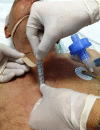Comparision of ultrasound-based methods of jugular vein and inferior vena cava for estimating central venous pressure
- PMID: 26379848
- PMCID: PMC4565231
Comparision of ultrasound-based methods of jugular vein and inferior vena cava for estimating central venous pressure
Abstract
Objective: The aim in this study was to compare the ultrasound estimation of the jugular vein diameter (IJVmax, IJVmin) and area (IJVarea), the height of the right internal jugular vein (CVPusg), the vena cava diameter (IVCmax, IVCmin), and the vena cava index (IVCindex) with direct estimation of central venous pressure (CVPinv).
Methods: Ultrasonography was performed on 37 nonventilated and 36 ventilated patients while monitoring central venous pressure. The IJV and IVC were measured during the respiratory cycle and the IJVarea and IVCindex were calculated. Tapering portion of the right IJV defined and height from this point to the sternal angle was used to estimate CVPusg.
Results: A CVP of 10 mmHg was chosen as a clinically significant cutoff for high CVP, and 6 mmHg was chosen for low CVP estimation. The CVPusg, IJVmax and IJVmin correlated moderately with CVPinv (R² = 0.66, 0.53, and 0.54, respectively) whereas the IVCmax, IVCmin and IVCindex showed poor correlation (R² = 0.29, 0.32 and 0.27, respectively). The CVPusg cutoff value of 7 predicted CVPinv > 10 mmHg with sensitivity of 90%, specific-ity of 67.3% and predicted CVPinv < 6 mmHg with sensitivity of 77%, specificity of 68%. IJVmax, IJVmin, IJVarea and IVCmax showed high sensitivity (90.32%, 83.87%, 90.32%, and 93.10%, respectively) for low CVP levels. The IVCindex has high sensitivity (95.2%) and poor specificity (42.9%) for high CVP levels.
Conclusion: IVCindex and CVPusg has better diagnostic performance for estimating high CVP. IJVmax, IJV area, and IVCmax showed high sensitivity and NPV for low CVP levels.
Keywords: Jugular vein; central venous pressure; ultrasound; vena cava inferior.
Figures





References
-
- Prekker ME, Scott NL, Hart D, Sprenkle MD, Leatherman JW. Point-of-Care ultrasound to estimate central venous pressure: a comparison of three techniques. Crit Care Med. 2013;41:833–41. - PubMed
-
- Donahue SP, Wood JP, Patel BM, Quinn JV. Correlation of sonographic measurements of the internal jugular vein with central venous pressure. Am J Emerg Med. 2009;27:851–5. - PubMed
-
- Siva B, Hunt A, Boudville N. The sensitivity and specificity of ultrasound estimation of central venous pressure using the internal jugular vein. J Crit Care. 2012;27:315, e7–e11. - PubMed
-
- Jang T, Aubin C, Naunheim R, Char D. Ultrasonography of the internal jugular vein in patients with dyspnea without jugular venous distention on physical examination. Ann Emerg Med. 2004;44:160–8. - PubMed
-
- Baumann UA, Marquis C, Stoupis C, Willenberg TA, Takala J, Jakob SM. Estimation of central venous pressure by ultrasound. Resuscitation. 2005;64:193–9. - PubMed
LinkOut - more resources
Full Text Sources
Medical
